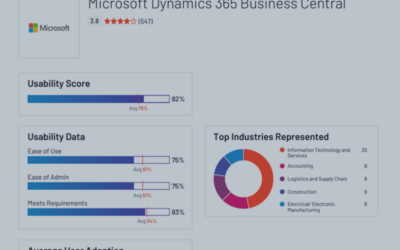At some point, every expanding business needs to take a close look at their technology infrastructure to ensure it suits their growth requirements. For CEOs, this often means finding yourself at a point where you must choose an ERP system to administer and control your resources throughout the organization.
Your existing legacy systems, CRM, and on-site servers may have been useful when the company was new, but processes are becoming more complex as you expand. You realize the current system needs a full revamp, moving to a safe, scalable, and cost-effective ERP solution.
This realization is the first crucial step in your ERP journey, but like most other major changes, it won’t happen overnight. There is still a lot of work to be done. The average timeframe for your ERP selection journey is around 7 months. To give you a better idea of what to expect during your ERP selection journey, Intelligent Technologies has prepared this informative guide.
Phase 1: Identifying needs across the organization
Your search for a new ERP system should start by identifying and outlining the exact needs that aren’t being covered by your current system. This requires open communication and collaboration among the leaders of every department
Have them gather feedback from their teams to find out where your current software isn’t meeting their needs, as well as what they think would make their job easier and more efficient. This phase can be a somewhat lengthy process, but it is of utmost importance to understand what your organization needs from its ERP. The information you gather here will tell you what to look for when comparing your ERP system options.
A few questions to consider:
- Does your company have industry-specific compliance standards?
- Does your company need support for a mobile sales team?
- Do you prefer a cloud, on premise or hybrid solution?
Mapping out key business processes and forecasting growth will also give you with a clearer idea of what to look for. The initial phase is intended to put the CEO, CIO, and other business leaders on the same page as to what is needed in each of their areas.
Phase 2: Finding a Vendor
Once the requirements for the ERP system have been identified, it’s time to find the ideal product and the right vendor who sells it. If there are already some shortlisted vendors, you’ll want to make sure you ask for references that compare to your organization in size and industry. Talking to these references will help point you in the right direction for a suitable ERP and solutions provider.
For example, a vendor with Cloud ERP experience such as, Intelligent Technologies, Inc. can help you if you need customized integrations to Acumatica, while other vendors may only be able to provide defined packages of service. If you are just starting a shortlist and don’t have any particular vendor in mind, then searching on business networks such as LinkedIn, online directories and forums like accountingsofware411.com or softwareadvice.com, and industry publications can lead you the right vendor. The best ERP system vendors take the time to educate their target clientele by making expert advice and other key information available online.
Phase 3: Implementation and Adaptation
Once you’ve found the product that fits and a vendor you can trust, it’s time to implement the solution. Your vendor should act as a partner, ready to assist in the migration process and provide your staff with the resources it needs to adapt to your new Cloud ERP system. Set realistic expectations for when the system can be fully implemented and functioning; there will be a learning curve to deal with along with necessary training to ensure the system is being used fully.
Let us help find the right ERP system for your business. Contact us today for a free consultation with a member of our friendly, knowledgeable staff. You can also follow us on Twitter and LinkedIn for news and information on ERP Solutions.




